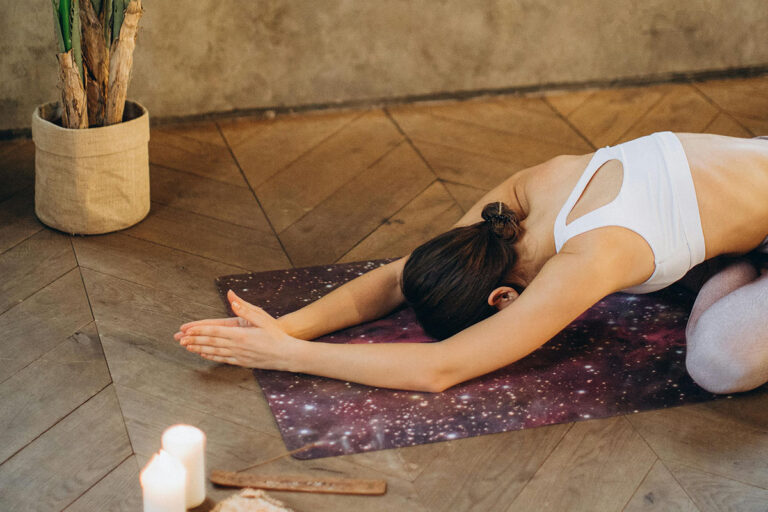In today’s fast-paced, overstimulated world, rest can feel like a luxury — even though it’s essential for healing and overall well-being. Enter Restorative Yoga, a gentle, therapeutic practice that invites deep rest, quiet stillness, and emotional recovery.
More than just a “relaxing” yoga style, Restorative Yoga is a powerful tool for nervous system regulation, trauma healing, and stress reduction. It’s the antidote to doing — a conscious shift toward being.
🧘 What Is Restorative Yoga?
Restorative Yoga is a passive, meditative form of yoga that uses props (blankets, bolsters, blocks) to fully support the body in poses held for extended periods — usually 5 to 20 minutes. Unlike active yoga styles, there’s no effort, stretching, or engagement of muscles.
The goal is simple but profound:
🌌 Create stillness, reduce stimulation, and allow the body to heal itself.
🪑 Key Features of Restorative Yoga
- Long-held poses (without tension)
- Fully supported by props
- Minimal movement, deep relaxation
- Emphasis on breath awareness and mindfulness
- Quiet, dark, peaceful environments
🧠 The Science: Why Doing Less Works
When you slow down, you activate the parasympathetic nervous system — your body’s rest-and-digest state. This lowers cortisol (stress hormone), reduces heart rate, and shifts your physiology toward healing.
Health benefits include:
- Lower blood pressure
- Improved immune function
- Reduced anxiety and depression
- Enhanced digestion and sleep
- Emotional regulation and trauma recovery
- Faster healing after injury or illness
🩺 Restorative yoga is now integrated into hospitals, cancer care centers, trauma therapy programs, and addiction recovery for its therapeutic value.
🧘♀️ Sample Restorative Yoga Poses
Here are a few classic poses and their benefits:
1. 🛏️ Supported Child’s Pose (Balasana)
Calms the mind, releases tension in the back and hips
Use a bolster or folded blanket under your chest and head for complete support.
2. 💜 Reclining Bound Angle Pose (Supta Baddha Konasana)
Opens the chest and hips, aids digestion, supports hormone balance
Place blocks or blankets under your knees and a bolster along your spine.
3. 🌙 Legs Up the Wall (Viparita Karani)
Reduces fatigue, eases swollen feet, calms the nervous system
Lie on your back with your legs resting vertically up a wall or chair.
4. 💤 Supported Savasana (Final Resting Pose)
Deep, full-body relaxation
Use props under the knees, neck, and arms. Cover yourself with a blanket, dim the lights, and allow complete surrender.
🕯️ Restorative vs. Yin Yoga: What’s the Difference?
While both styles are slow and meditative, Yin Yoga focuses on deep stretching of connective tissue, and includes mild intensity.
| Feature | Restorative Yoga | Yin Yoga |
| Intensity Level | Minimal, fully passive | Moderate, stretching involved |
| Goal | Deep rest and nervous system reset | Stretching fascia and joints |
| Use of Props | Extensive | Minimal |
| Target Audience | Anyone needing rest | Those seeking deeper flexibility |
🧘♂️ Who Should Practice Restorative Yoga?
Everyone can benefit from restorative yoga — especially:
- People with chronic stress or burnout
- Those recovering from illness or surgery
- Individuals with anxiety, depression, or trauma
- Pregnant or postpartum women
- Athletes or overworked professionals
- Seniors or those with limited mobility
- Anyone seeking stillness, softness, and inner calm
“Restorative Yoga isn’t lazy yoga. It’s a radical act of self-care.”
🪷 Tips for Practicing Restorative Yoga
- Use plenty of props. The more supported your body is, the more your mind will relax.
- Practice in a quiet, dim space. Soften the lighting, reduce noise, and turn off distractions.
- Set a timer. 10–20 minutes per pose allows for deep release.
- Stay warm. Use blankets and socks to prevent your body from getting cold.
- Focus on the breath. Deep, slow breathing will deepen the relaxation response.
- Avoid stimulation afterward. Let the effects linger by staying in a restful state post-practice.
🧭 Final Thoughts: Rest Is a Practice
In a world that often glorifies hustle and busyness, Restorative Yoga teaches us to slow down and listen. It gently reminds us that healing doesn’t always come through effort — sometimes, it arises through stillness, surrender, and silence.
“The quieter you become, the more you can hear.” — Ram Dass
Whether practiced once a week or as part of a daily routine, Restorative Yoga is a sacred space to return to yourself.



